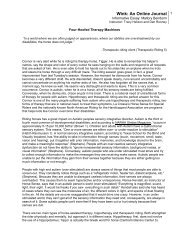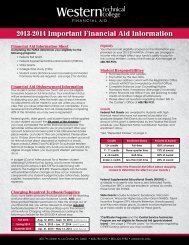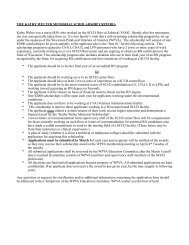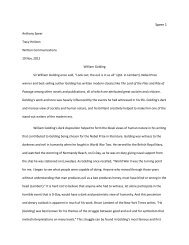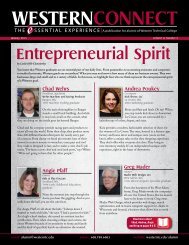The History of Western Technical College
The History of Western Technical College
The History of Western Technical College
You also want an ePaper? Increase the reach of your titles
YUMPU automatically turns print PDFs into web optimized ePapers that Google loves.
Part II - <strong>The</strong> Vocational School - 1917-1963<br />
Our School<br />
<strong>The</strong> Vocational School's purpose is threefold: to give advice, give help, and<br />
give guidance to all people to enable them to meet new occupational<br />
situations. <strong>The</strong> philosophy held by the La Crosse Vocational and Adult Schools<br />
is that it is never too big to care for individual cases.<br />
Federal legislation (the Smith-Hughes Act <strong>of</strong> 1917 made available federal funding for state and local<br />
vocational schools authorized by the state functioning under a "state board <strong>of</strong> vocational and industrial<br />
education." Wisconsin was one <strong>of</strong> the first states to qualify for aid under the Smith-Hughes Act because it<br />
was organized in 1911.<br />
"Send us your rag-tag and bob-tail, the output and put-out <strong>of</strong> public schools, and<br />
we'll make a place for them all." <strong>The</strong> worst punishment that could be thought <strong>of</strong> in those early days was to<br />
send boys and girls down to the vocational school where someone would attempt to understand them and<br />
make something out <strong>of</strong> them.<br />
La Crosse Vocational School<br />
It was 1916 and John Coleman was teaching in Milwaukee. On Labor Day, he received a phone call from the<br />
state director <strong>of</strong> industrial education telling him to apply for the directorship <strong>of</strong> the school at La Crosse.<br />
Coleman thought the man had made a mistake and ignored the call. He went to his old job the next<br />
morning. His boss was astonished to see him and asked him why he hadn't gone to La Crosse. <strong>The</strong>n he knew<br />
the call had been a serious one. He finished the day <strong>of</strong> teaching and caught the night train to La Crosse. <strong>The</strong><br />
next morning he had his interview with board members Louis Hirscheimer <strong>of</strong> the La Crosse Plow Company<br />
(formerly the Allis-Chalmers Manufacturing Company, located at 401 North Third Street in La Crosse) and<br />
Adolph Schroeder, brew master <strong>of</strong> the Gund Brewery (then located on Mormon Coulee Road between South<br />
9 th and South 10 th Street by Gundersen-Lutheran.) <strong>The</strong>y apparently liked what they saw and hired Coleman.<br />
When John B. Coleman came to La Crosse in September 1916 as director <strong>of</strong> the Vocational School, the<br />
school had been in existence for only four years. At that time, there were four day school instructors. An<br />
additional room was acquired at Longfellow School (corner <strong>of</strong> Sixth and Vine Street) on a half-time basis.<br />
Day school students numbered 487 and night students 12,533.<br />
A survey <strong>of</strong> preferences in work that La Crosse Vocational School pupils wished to take, made in 1916-17,<br />
resulted in additions to the curriculum. Choices <strong>of</strong> boys ranked in this order: machine shop, electricity,<br />
commercial work and auto mechanics. At that time, no phase <strong>of</strong> woodworking was chosen. With that<br />
information, the Board <strong>of</strong> Industrial Education immediately hired a machine shop instructor and obtained<br />
use <strong>of</strong> the high school shop in the afternoons. A similar survey in the girls department added sewing,<br />
cooking, commercial work, millinery and homemaking.





